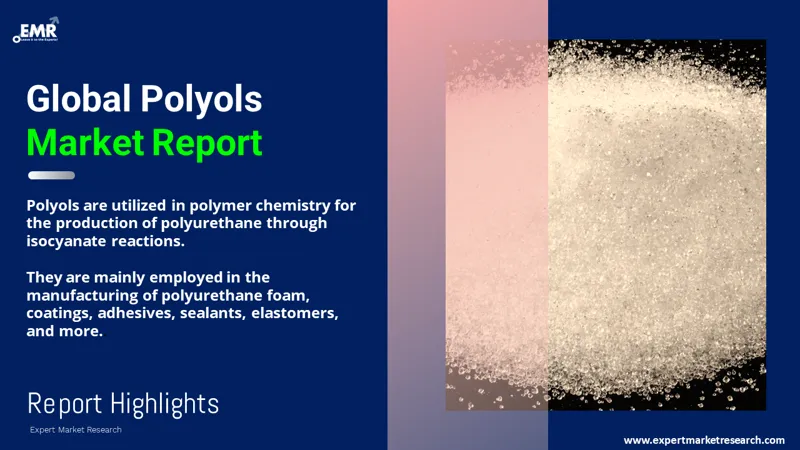
Consumer Insights
Uncover trends and behaviors shaping consumer choices today
Procurement Insights
Optimize your sourcing strategy with key market data
Industry Stats
Stay ahead with the latest trends and market analysis.
Trending Now



The global polyols market reached approximately USD 30.88 Billion in 2024. The market is projected to grow at a CAGR of 6.00% between 2025 and 2034, reaching a value of around USD 55.30 Billion by 2034.
Base Year
Historical Year
Forecast Year






Value in USD Billion
2025-2034
Polyols Market Outlook
*this image is indicative*
| Global Polyols Market Report Summary | Description | Value |
| Base Year | USD Billion | 2024 |
| Historical Period | USD Billion | 2018-2024 |
| Forecast Period | USD Billion | 2025-2034 |
| Market Size 2024 | USD Billion | 30.88 |
| Market Size 2034 | USD Billion | 55.30 |
| CAGR 2018-2024 | Percentage | XX% |
| CAGR 2025-2034 | Percentage | 6.00% |
| CAGR 2025-2034 - Market by Region | Asia Pacific | 6.8% |
| CAGR 2025-2034 - Market by Country | India | 7.8% |
| CAGR 2025-2034 - Market by Country | Brazil | 7.1% |
| CAGR 2025-2034 - Market by Application | CASE (Coatings, Adhesives, Sealants & Elastomers) | 6.6% |
| CAGR 2025-2034 - Market by Industry | Automotive | 6.9% |
| Market Share by Country 2024 | Italy | 3.1% |
Polyols are used in polymer chemistry to generate isocyanate reaction polyurethane, primarily used to manufacture polyurethane coatings, adhesives and sealants, and elastomers, among others. They are naturally found in fruits and vegetables, and they can also be produced industrially. Polyols are commonly used as sweeteners and bulking agents in sugar-free and reduced-calorie foods, as they provide fewer calories than regular sugar and have a lower impact on blood glucose levels.

Read more about this report - REQUEST FREE SAMPLE COPY IN PDF
With increasing awareness of the health risks associated with high sugar consumption, such as obesity, diabetes, and heart disease, there is a growing demand for sugar substitutes which boosts the polyols market growth. Polyols are popular sugar alternatives because they provide sweetness with fewer calories and a lower glycemic index. The food and beverage sector is a major consumer of polyols, using them in products like sugar-free candies, chewing gums, baked goods, and beverages and the expansion of this sector, particularly in emerging markets, is driving the demand for polyols. Polyols are also used as excipients in pharmaceuticals and as humectants in personal care products and the growth of these sectors contributes to the market.
Shift towards bio-based polyols; increasing demand for low-VOC and non-toxic polyols; development of specialised polyols for niche applications; and advancements in polyol technology are the major trends impacting the polyols market expansion
Bio-based polyols are derived from renewable resources such as vegetable oils, corn, and sugar, and they offer a reduced carbon footprint and lower environmental impact.
Consumers and industrial sectors are increasingly seeking polyols that are low in volatile organic compounds (VOCs) and non-toxic, driven by health and environmental concerns.
There is a trend towards developing specialised polyols for niche applications, such as medical devices, electronics, and coatings in the polyols market.
Technological advancements in polyol production and processing are enabling the development of polyols with enhanced properties, such as improved durability, fire resistance, and thermal insulation.
The increasing demand for polyols that are low in volatile organic compounds (VOCs) and non-toxic is driven by a heightened awareness of health and environmental concerns. As a result, consumers and industrial sectors are seeking safer alternatives that minimise exposure to harmful chemicals and reduce environmental impact which has led to the development of polyols with improved safety profiles, characterised by low VOC content and non-toxic properties. These polyols are formulated to reduce the emission of harmful compounds, making them safer for use in indoor environments and in close contact with humans.
Market players are establishing partnerships for the distribution of bio-based polyols. Nordmann, a global distribution company, announced a partnership with Weylchem, a manufacturer of speciality chemicals in February 2024, to distribute Weylchem's Velvetol brand of bio-based polyether polyols. These polyols are derived from renewable resources and are designed to serve as a sustainable alternative to traditional petroleum-based polyols.

Read more about this report - REQUEST FREE SAMPLE COPY IN PDF
“Polyols Market Report and Forecast 2024-2032” offers a detailed analysis of the market based on the following segments:
Market Breakup by Type
Market Breakup by Application
Market Breakup by Industry
Market Breakup by Region
Polyether polyols account for a major share due to their growing usage in multiple end-use sectors
Polyether polyols are highly versatile and can be used in a wide range of applications, including flexible and rigid foams, adhesives and sealants, and coatings and this versatility makes them attractive for various industrial sectors, such as automotive, construction, and furniture. Polyether polyols also offer excellent performance properties, such as good resilience, high elasticity, and resistance to hydrolysis, which make them suitable for use in high-quality polyurethane products. Polyether polyols are easy to process and can be tailored to meet specific end-use requirements and this ease of processing allows manufacturers to develop customised solutions for their customers.
Polyester polyols are anticipated to gain sizeable growth in the polyols market in the forecast period. Polyester polyols are often preferred in the production of polyurethane foams due to their excellent mechanical properties, superior adhesion, and resistance to hydrolysis, oil, and solvents. These properties make polyester polyols ideal for producing high-quality, durable polyurethane products. As industrial sectors seek materials that offer enhanced performance characteristics, the demand for polyester polyols increases. For example, in the automotive sector, polyester polyols are used to produce lightweight, durable, and heat-resistant components, contributing to fuel efficiency and safety.
The building and construction sector maintains its dominance in the market due to the rising usage of polyurethane foam in energy-efficient buildings
The building and construction sector typically holds the largest share in the polyols market. Polyols are a key component in the production of polyurethane foam, which is widely used in the building and construction sector for insulation, roofing, sealants, and adhesives. The demand for energy-efficient buildings and the need for effective insulation materials drive the consumption of polyols in this sector. Governments around the world are implementing stricter regulations regarding energy efficiency and fire safety in buildings and polyurethane foams made from polyols offer excellent thermal insulation and fire-resistant properties, making them a preferred choice for meeting these regulatory standards.
The automotive sector is expected to gain robust growth in the forecast period. Polyols are crucial for producing polyurethane foams and elastomers used extensively in the automotive sector and these materials are utilised for seating, headrests, armrests, dashboards, interior trim, and insulation, contributing to comfort, safety, and noise reduction.
The market players are increasing their collaboration and increasing the manufacture of sustainable polyols to gain a competitive edge in the polyols market
Founded in 1865 and headquartered in Ludwigshafen, Germany, specialises in chemicals, plastics, performance products, agricultural solutions, and oil and gas.
Established in 1907 in The Hague, Netherlands, focuses on oil, natural gas, gasoline, diesel, lubricants, and various petrochemicals.
Founded in 1897 in Michigan, United States, produces polyethylene, polyurethane, silicone, and specialty chemicals.
Established in 1978 in Shandong, China, is known for manufacturing MDI (methylene diphenyl diisocyanate), TDI (toluene diisocyanate), and various polyurethane systems.
*Please note that this is only a partial list; the complete list of key players is available in the full report. Additionally, the list of key players can be customized to better suit your needs.*
Other key players in the polyols market Covestro AG, Huntsman International LLC, Stepan Company, and Repsol S.A., among others.
The Asia Pacific is the leading region of the market. The rising automotive sector in the region is expected to remain a main factor in driving the regional market along with increased polymer consumption. The rising middle-class population and increasing disposable incomes in the Asia Pacific region are also leading to higher demand for consumer goods, including electronics, furniture, and footwear as polyols are used in manufacturing various components of these products, such as cushioning, insulation, and coatings. Technological advancements and innovation in polyol production and applications are making these materials more accessible and cost-effective, further driving their demand in the region.
| CAGR 2025-2034 - Market by | Country |
| India | 7.8% |
| Brazil | 7.1% |
| China | 6.5% |
| Mexico | 6.0% |
| USA | 5.6% |
| Canada | XX% |
| UK | 5.3% |
| Germany | XX% |
| Italy | XX% |
| Japan | XX% |
| Australia | XX% |
| Saudi Arabia | XX% |
| France | 4.8% |
The other major consumer of the product is Europe, led by Germany, the United Kingdom, and France. The rising demand for energy-efficient insulation in low-income households, together with favourable government regulatory aid, is predicted to boost the polyols market in Europe. The existence of various automobile manufacturers, along with the rising building and construction sectors in Latin America, is expected to drive market growth in the region.
Auto Parts Manufacturing Market
Cash In Transit Services Market
Database Management System (Dbms) Market
*While we strive to always give you current and accurate information, the numbers depicted on the website are indicative and may differ from the actual numbers in the main report. At Expert Market Research, we aim to bring you the latest insights and trends in the market. Using our analyses and forecasts, stakeholders can understand the market dynamics, navigate challenges, and capitalize on opportunities to make data-driven strategic decisions.*
Get in touch with us for a customized solution tailored to your unique requirements and save upto 35%!
The global polyols market reached a value of USD 30.88 Billion in 2024.
The global polyols market is projected to grow at a CAGR of nearly 6.00% in the forecast period of 2025-2034.
The global polyols market is estimated to reach a value of about USD 55.30 Billion by the year 2034.
The major drivers of the global polyols market include rising disposable incomes, increasing population, rising construction industry, and the growing demand from the automobile sector.
The rising production of bio-based polyols is expected to be a key trend guiding the growth of the market.
North America, Europe, the Asia Pacific, Latin America, and the Middle East and Africa are the leading regions in the market, with the Asia Pacific accounting for the largest market share.
The major product types in the market include polyether and polyester polyols.
Polyols find wide applications in flexible polyurethane foam, rigid polyurethane foam, and CASE (coatings, adhesives, sealants, and elastomers), among others.
Based on industry, the market is divided into carpet backing, packaging, furniture, automotive, building and construction, electronics, and footwear, among others.
The major players in the market are BASF SE, Royal Dutch Shell Plc, Covestro AG, The Dow Chemical Company, Wanhua Chemical Group Co., Ltd., Huntsman International LLC, Stepan Company, and Repsol S.A., among others.
Explore our key highlights of the report and gain a concise overview of key findings, trends, and actionable insights that will empower your strategic decisions.
| REPORT FEATURES | DETAILS |
| Base Year | 2024 |
| Historical Period | 2018-2024 |
| Forecast Period | 2025-2034 |
| Scope of the Report |
Historical and Forecast Trends, Industry Drivers and Constraints, Historical and Forecast Market Analysis by Segment:
|
| Breakup by Type |
|
| Breakup by Application |
|
| Breakup by Industry |
|
| Breakup by Region |
|
| Market Dynamics |
|
| Competitive Landscape |
|
| Companies Covered |
|
| Report Price and Purchase Option | Explore our purchase options that are best suited to your resources and industry needs. |
| Delivery Format | Delivered as an attached PDF and Excel through email, with an option of receiving an editable PPT, according to the purchase option. |
Datasheet
One User
USD 2,499
USD 2,249
tax inclusive*
Single User License
One User
USD 3,999
USD 3,599
tax inclusive*
Five User License
Five User
USD 4,999
USD 4,249
tax inclusive*
Corporate License
Unlimited Users
USD 5,999
USD 5,099
tax inclusive*
*Please note that the prices mentioned below are starting prices for each bundle type. Kindly contact our team for further details.*
Flash Bundle
Small Business Bundle
Growth Bundle
Enterprise Bundle
*Please note that the prices mentioned below are starting prices for each bundle type. Kindly contact our team for further details.*
Flash Bundle
Number of Reports: 3
20%
tax inclusive*
Small Business Bundle
Number of Reports: 5
25%
tax inclusive*
Growth Bundle
Number of Reports: 8
30%
tax inclusive*
Enterprise Bundle
Number of Reports: 10
35%
tax inclusive*
How To Order
Our step-by-step guide will help you select, purchase, and access your reports swiftly, ensuring you get the information that drives your decisions, right when you need it.

Select License Type
Choose the right license for your needs and access rights.

Click on ‘Buy Now’
Add the report to your cart with one click and proceed to register.

Select Mode of Payment
Choose a payment option for a secure checkout. You will be redirected accordingly.
Gain insights to stay ahead and seize opportunities.

Get insights & trends for a competitive edge.

Track prices with detailed trend reports.

Analyse trade data for supply chain insights.

Leverage cost reports for smart savings

Enhance supply chain with partnerships.

Connect For More Information
Our expert team of analysts will offer full support and resolve any queries regarding the report, before and after the purchase.
Our expert team of analysts will offer full support and resolve any queries regarding the report, before and after the purchase.
We employ meticulous research methods, blending advanced analytics and expert insights to deliver accurate, actionable industry intelligence, staying ahead of competitors.
Our skilled analysts offer unparalleled competitive advantage with detailed insights on current and emerging markets, ensuring your strategic edge.
We offer an in-depth yet simplified presentation of industry insights and analysis to meet your specific requirements effectively.



Australia
63 Fiona Drive, Tamworth, NSW
+61-448-061-727
India
C130 Sector 2 Noida, Uttar Pradesh 201301
+91-723-689-1189
Philippines
40th Floor, PBCom Tower, 6795 Ayala Avenue Cor V.A Rufino St. Makati City,1226.
+63-287-899-028, +63-967-048-3306
United Kingdom
6 Gardner Place, Becketts Close, Feltham TW14 0BX, Greater London
+44-753-713-2163
United States
30 North Gould Street, Sheridan, WY 82801
+1-415-325-5166
Vietnam
193/26/4 St.no.6, Ward Binh Hung Hoa, Binh Tan District, Ho Chi Minh City
+84-865-399-124
United States (Head Office)
30 North Gould Street, Sheridan, WY 82801
+1-415-325-5166
Australia
63 Fiona Drive, Tamworth, NSW
+61-448-061-727
India
C130 Sector 2 Noida, Uttar Pradesh 201301
+91-723-689-1189
Philippines
40th Floor, PBCom Tower, 6795 Ayala Avenue Cor V.A Rufino St. Makati City, 1226.
+63-287-899-028, +63-967-048-3306
United Kingdom
6 Gardner Place, Becketts Close, Feltham TW14 0BX, Greater London
+44-753-713-2163
Vietnam
193/26/4 St.no.6, Ward Binh Hung Hoa, Binh Tan District, Ho Chi Minh City
+84-865-399-124
Share